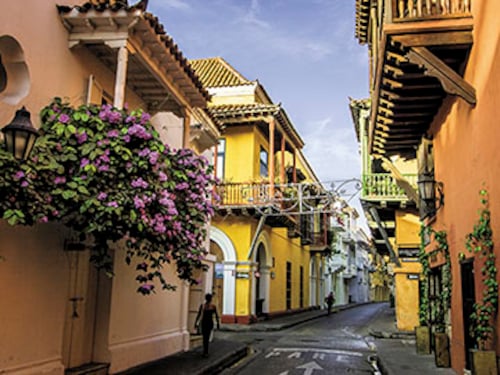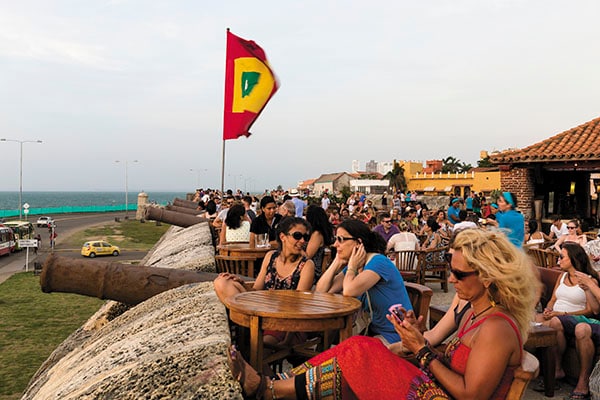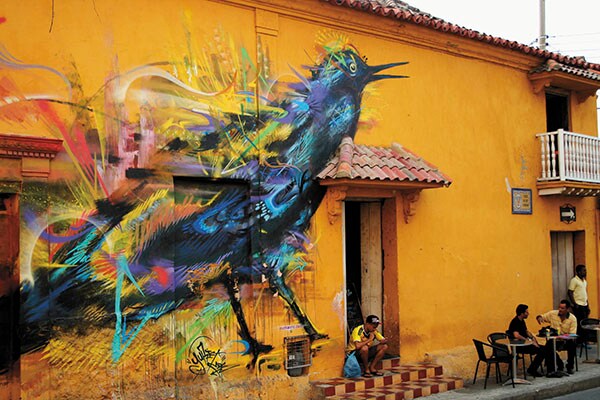Romancing the Colombian city of Cartagena
With labyrinthine cobblestone streets, homes painted in hues of orange and yellow and the clip-clop of horse carriages, this Colombian city rewards the aimless wanderer like few others do


We’ve been fascinated with Cartagena ever since we saw Romancing the Stone, the 1984 romcom with Michael Douglas at his swashbuckling best, Kathleen Turner playing the ingénue and Danny DeVito providing comic relief as a hapless criminal all chasing treasure buried somewhere in Colombia. It was, therefore, a bit of a let-down when, while conducting research for our trip in May last year, we learnt that every scene set in Colombia was actually filmed in Mexico.
But, rest assured, that was our only disappointment with this delightful city on the Caribbean Sea. And if your travels are to take you there — we strongly urge that they do — here are some suggestions that may come in handy.
Get lost
Maps aren’t particularly helpful in navigating this Unesco World Heritage destination where street names change at every intersection. That said, we recommend starting at the very centre: Torre del Reloj, or the clock tower, which has thankfully moved on from its past as a slave market and is now a hub of bars, hotels and shops. Tools of torture have been replaced by beer on tap and street vendors selling a variety of hand-made sweet and savoury treats.
Pick any route headed back into the old town and you’ll encounter streets lined with bougainvillea-draped homes. The heart of the old town can’t be more than 50 blocks, but has plenty to hold your interest. Inviting courtyards beckon behind high walls, art galleries abound and shops selling things you didn’t know you craved wait to be discovered. This city rewards the aimless wanderer as few others do.
Circle the (old) city
For several decades after it was founded in 1533, Cartagena lacked man-made defences. A pirate attack in 1586 led to the decision to build a wall—Las Murallas—around the city which took around 208 years to complete. While Las Murallas doesn’t completely encircle the city, you can walk a large part of it, to gentle breezes from the Caribbean Sea on one side and sights of the old city on the other.  Image: Thierry Tronnel/ Corbis
Image: Thierry Tronnel/ Corbis
Café del Mar bar
In parts, Las Murallas is 20-25 feet above the ground, giving you a completely different perspective of Cartagena. Oftentimes, the rampart widens generously allowing bars such as Café del Mar to sprawl. You can sit at an al fresco café or buy a can of the ubiquitous Aguila beer from hawkers wandering the rampart. Interspersed at every few feet, there are gaps in these mighty walls, the remnants of a martial past when the space was occupied by cannons. Unfazed by such history, the gun emplacements are now occupied by honeymooners watching a golden sunset over the water. But, before you set out, beware of the heat. The weather in Cartagena is predictable: The sun beats down relentlessly bright and hot. (The nights are cooler, but they are also as sultry as the beauties the country is famous for.) So unless you spend the peak of the day in the shade, you’re being foolhardy. We ventured out at 11 am one day, with the reckless plan of taking a boat to Islas del Rosario. We made it to the port, scorched despite the protection of a
cap, sunglasses and SPF 70 sunscreen, and quickly abandoned our plan in favour of a chilled limonada de coco (coconut milk, condensed milk, lime juice) in the shade.
Get to the art of it
The city is a haven for artists, art dealers, art investors and those that appreciate a thing of beauty. While there are several renowned museums here, you’re just as likely to stumble upon interesting galleries you didn’t set out to find. One such is the Casa Museo La Presentacion on Calle Estanco del Aguardiente: It is a lively gallery, theatre, antique store and hotel, all rolled into one. We particularly enjoyed a collection of photos that told the story of a whirlwind romance and subsequent betrayal, in true telenovela style.
There is nothing subtle about Cartagena. Think extravagant colours and shapes. This partiality to excess is reflected in the work of Colombia’s favourite artist, Fernando Botero, well known for his “fat”—as he calls them himself—figures. Consider his sculpture Gertrude Gorda (Fat Gertrude), which has pride of place in Plaza Santo Domingo. A keen observer will notice that Gertrude’s breasts and buttocks shine brighter than the rest of her. This is to be expected as rubbing the former supposedly grants luck while the latter ensures a long romance. (Or you could rub both areas, just to be safe.)
Cartagena’s role as a primary port for the shipment of gold, silver and emeralds from the New World to the Old made it a tempting target for pirates and mercenaries. The city seems to have learnt its lesson over the centuries—the beautifully carved doors of the homes in the old city look stout enough to repel the most determined invaders, or they could simply be works of art that protect the secret courtyards, patios and boutiques within.
As if rebelling against the colonial splendour of the old city, Getsemani celebrates art in the form of magnificent graffiti. The neighbourhood was once a magnet for freed slaves, mulattos and artisans. More recently, it was rife with high levels of crime, drug dealing and prostitution but has since undergone a welcome renaissance.
Getsemani’s rich and complicated history is probably why the graffiti features themes of resistance and deliverance. Consider the Maria Mulata on one of the walls around Plaza de la Trinidad. According to legend, the Maria Mulata (the ‘great-tailed grackle’ or ‘blackbird’) was a mellifluous, multi-coloured bird that once rescued humans threatened by fire by flying them to safety. Alas, the numerous trips through the smoke and soot caused it to lose both its looks and voice—so much for altruism. Express yourself
Cartagena was one of the first sanctuaries for freed African slaves in the Americas and it effortlessly embraces Spanish, Caribbean and Latin influences into a distinctive melange.
The people are warm, helpful and polite. “Permiso” (literally “permission”) is an oft-heard word whether someone’s requesting you to give way, putting a plate in front of you, clearing it away or, it is easy to imagine, even robbing you of your wallet.
However, the polite demeanour disappears when locals are confronted with questions or suggestions they deem absurd. Their response in such situations is an incredulous “What?” in a pitch that’s several notches higher than normal, accompanied by eyebrows that almost reach their hairline. We, too, were at the receiving end of such a reaction, from our concierge, when we asked whether a trip to Bazurto market was worth making. “Why?” was followed quickly by, “Do you want to get robbed?” We decided to filter our questions going forward but still witnessed several versions of that exasperated expression.
It is also a city where not knowing the vernacular can be a hindrance. “No entiendo” (“I don’t understand”) along with an apologetic smile is the most likely response to queries in English. When one of us became grumpy due to a ear affliction, we had to use sketches and charades to describe the symptoms to a pharmacist. When he misunderstood (and almost sent us to the closest body piercing parlour), we decided to resort to Google translate. So thrilled was our pharmacist that halfway through the “conversation”, he provided us with a perfect diagnosis.
Embrace the night
 Image: Surbhee Grover and Vijay Balasubramanian
Image: Surbhee Grover and Vijay Balasubramanian
Maria Mulata painted on a wall in Plaza de la Trinidad
Nocturnal experiences in Cartagena can take many forms—all brimming with the promise of adventure. On our first night, we found ourselves in Plaza de la Trinidad, the heart of Getsemani. There’s a church on one side with steps that provide convenient seating. Kids were playing an impromptu soccer match in the plaza, while vendors supplied the crowd with delicious street food there was a DJ in one corner as well.
Demente, a tapas bar right on the plaza, with rocking chairs near the door, made for a relaxing spot to grab some beers and watch the activity outside. MK Gandhi, Michael Jackson, Andy Warhol, Lady Gaga and others looked upon us approvingly from paintings on the exposed brick walls. Stylish lamps swayed from high beams and the open roof allowed us to gaze at the stars.
Our second evening was spent at El Baron, a cocktail bar in Plaza de San Pedro Claver. We watched the master bartender craft a Gin Basil Smash—gin with lemon juice, syrup and fresh basil—and then, chose the seating outside in the shadow of San Pedro Claver church. We soaked in the balmy full moon night until well after the church’s bell struck twelve.
On the third night, we headed to Plaza de Santo Domingo to meet a couple we had befriended while waiting in the immigration line. The plaza gets its name from the Church of Santo Domingo, the oldest in Cartagena. The bell tower looks distinctly crooked, apparently the result of the devil jumping on it and shaking it when it was near completion.
The area is packed with tables and it’s hard to tell the boundaries between establishments. Overzealous touts try to lure customers by flashing smiles and waving menu cards frantically. Even on a Sunday night, the plaza was bustling with energy. Later, we walked down to El Baluarte, a wonderful bar on the ramparts in front of the Charleston Hotel and a distinctly more relaxed setting.
When one of us learnt that Juan del Mar, a Colombian soap opera star and bullfighter, owned an eponymous restaurant in Plaza San Diego, we simply had to visit. We didn’t see any sexy Latin screen gods, but we did enjoy drinks by a church that seemed to change colour every few moments. Show up hungry
Cartagena’s coastal location and Afro-Caribbean flavours make for delightful seafood. With that in mind, our first stop for lunch was La Mulata on Calle Quero. Too much choice can be detrimental to happiness, but La Mulata makes no such mistake. Its simple menu boasts a small selection of seafood-based soups and rice dishes. We started with fried plantains and a fish soup followed by fish in a creamy garlic sauce with shrimp served on coconut rice topped with avocado. You could embellish your meal with one of the sauces provided, but there is little point in messing with a meal that comes so close to perfection.
Now you know a dish is truly worth trying when several nations lay claim to its invention. Such is the fame of ceviche, raw fish cured in citrus juices and spiced with peppers, celery, chopped onions, salt and herbs. Our quest for ceviche in Cartagena was not an easy one as our first choice eatery, El Boliche Cebichería, was shut when we arrived.
Luckily, we happened to stumble upon La Cevichería just beside the famed Santa Clara monastery (now a Sofitel). They were experiencing a power cut and we could see the patrons melting before our very eyes. Undeterred, we sat down and ordered the “mega” cup of shrimp ceviche. In Peru, ceviche is served with slices of cold sweet potatoes or corn-on-the-cob. In Ecuador, popcorn, or nuts are common accompaniments. Not so in Cartagena, where the dish is served with unassuming saltine crackers so that nothing detracts from the star of the show. And nothing could possibly take away from the fresh, cool, tart taste of the marinade or the shrimp, which was at once firm and delicate. The mango salsa only added to the symphony of flavours that erupted in our mouths with every bite.
On our last day in Cartagena, we’d planned a couple of special meals to enliven our departure. La Cocina de Pepina, run by an aunt-nephew duo, was our pick for lunch. Having encountered several shuttered storefronts during our visit, we had our hotel call to confirm that the restaurant was open until 4 pm. We arrived at 2.45 pm to find every door and window clasped tightly shut. We knocked several times and the door was eventually opened by a man who tried his best to dissuade us. When we didn’t flinch, he asked, “Have reservation?” We nodded, at which he sighed audibly and let us into the tiny space that was bereft of life except for him, a sleepy assistant and two hyperactive flies.
We ordered what he recommended as “the most traditional” dish on the menu—Mote de Queso. It arrived in less than eight minutes. Perhaps that should have warned us. This soupy dish was a rather bland blend of various types of fat, chunks of cheese and vegetables (on closer inspection, we discovered it was eggplant) floating on it. The side of slightly sweet, slightly smoky coconut rice, on the other hand, was delicious and we showed our appreciation by making sure there wasn’t a morsel left.
For dinner, it was back to the old city for a meal at Maria, a high-end restaurant on Calle del Colegio. The flamboyantly decorated space (the tiger murals reminded us of places far away) serves a variety of dishes and you can’t go wrong with whatever you pick.
Needless to say, we were only able to sample some of Cartagena’s plentiful delights. With that thought, on the flight back, we ran our standard litmus test—would we be back in five years? The ayes firmly had it.
First Published: Mar 31, 2016, 06:22
Subscribe Now